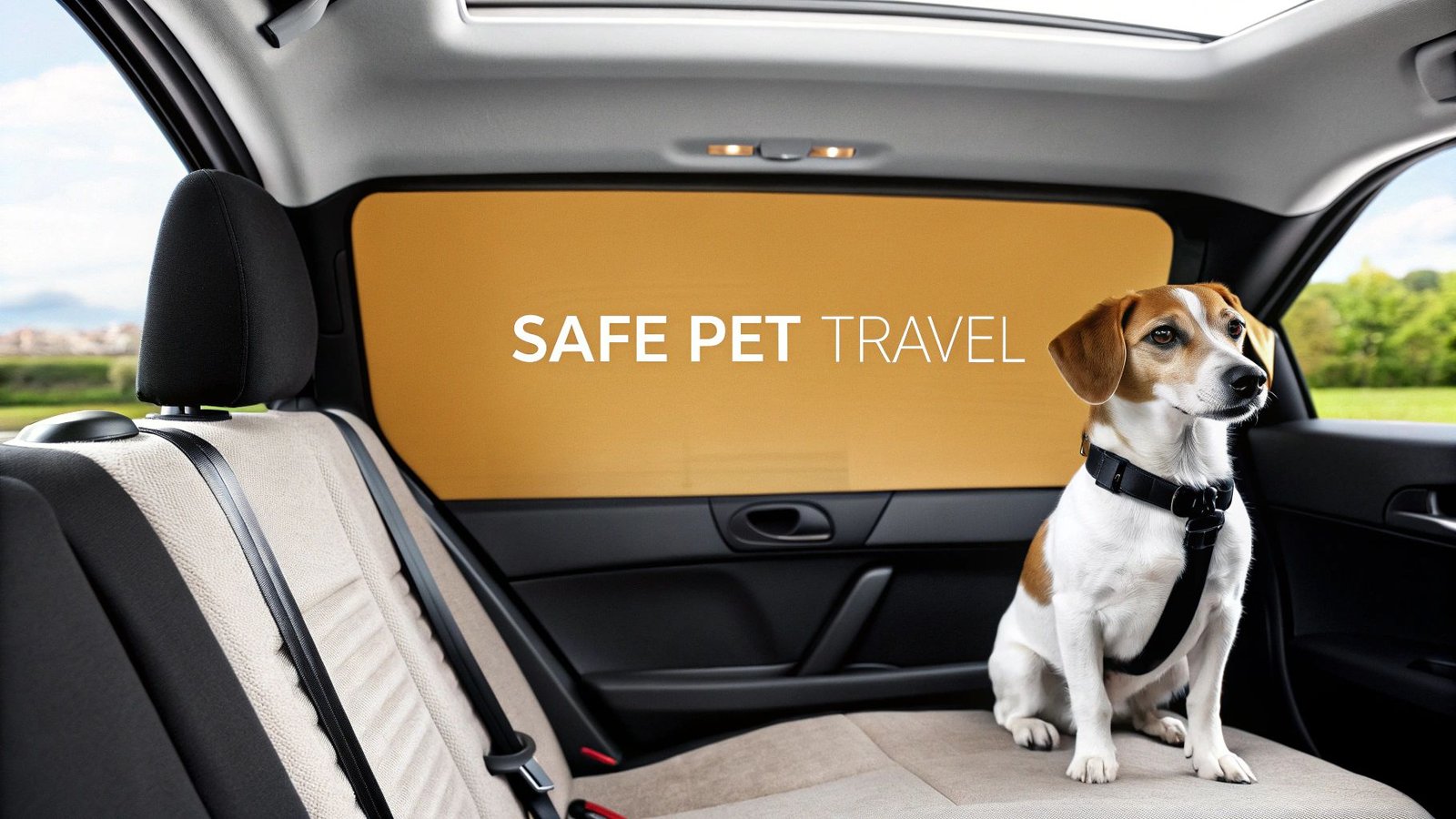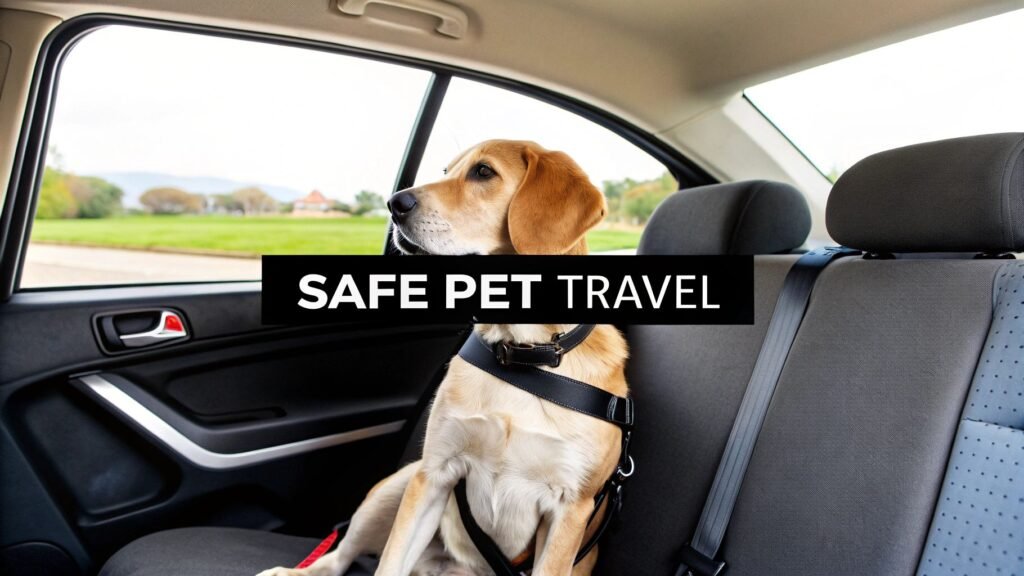Your Guide to a Pet Seat Belt Clip

Let’s be honest, when you think about your dog in the car, you’re probably picturing them with their head happily out the window, ears flapping in the wind. It’s a classic image, but it’s also a dangerous one. A pet seat belt clip is a simple, brilliant little device that bridges the gap between your dog’s harness and your car’s seat belt lock. It keeps them securely in their spot, preventing them from turning into a furry projectile if you have to slam on the brakes.
This isn’t just about protecting your pet; it’s about protecting everyone in the car.
Why a Seat Belt Clip is a Non-Negotiable for Your Pet
Most of us immediately think about major car accidents when we talk about pet restraints. And yes, a clip is absolutely critical in a collision. But its real day-to-day value comes into play during those much more common, heart-stopping moments on the road.
Think about the last time you had to swerve to avoid a pothole or brake hard because someone cut you off. An unsecured pet can easily be launched from their seat, crashing into the dashboard, a window, or even you.
The physics here are frighteningly simple. In a sudden stop from just 30 mph, an unrestrained 60-pound dog can fly forward with an impact force of around 2,700 pounds. That’s enough to cause catastrophic injuries to your pet and anyone they hit.
It’s About More Than Just Bracing for Impact
Beyond the obvious physical dangers, there’s another huge risk: distracted driving. An anxious or overly excited pet wandering around the car is a recipe for disaster.
I’ve heard stories of pets who:
- Decided the driver’s lap was the best place to be on the highway.
- Blocked the rearview mirror at a critical moment.
- Accidentally nudged the gear shift or got tangled in the steering wheel.
This isn’t a small issue. Many states now have laws against driving with an unrestrained animal because it’s a known form of distracted driving, and getting caught can mean hefty fines. Using a pet seat belt clip isn’t just a good idea—it’s often a legal requirement to keep your focus where it belongs: on the road.
Think of it this way: a dedicated restraint for your pet isn’t just another accessory. It’s essential safety gear, every bit as important for your furry family member as a car seat is for a child.
This shift in thinking is catching on. The global market for pet car seat belts was valued at about $500 million in 2025 and is expected to climb as more pet owners get serious about travel safety. You can dive into the full market research about pet car seat belts to see just how big this trend is becoming.
Ultimately, a simple clip transforms your car into a safer space for everyone inside, giving you real peace of mind on every trip.
Choosing the Right Pet Seat Belt System
Picking out a pet seat belt clip can feel a bit like wading through the toy aisle at a pet store—so many options, it’s hard to know where to start. You’ve got simple tethers, full-body harnesses, and everything in between. But don’t get overwhelmed. The right choice really just comes down to your dog’s size, personality, and the kind of trips you take.
After all, a nervous little Yorkie isn’t going to need the same setup as a big, goofy Labrador who loves to look out the window. Your goal is to find that sweet spot: a system that keeps them safe and secure without making them uncomfortable or anxious.

As you can see, it’s a two-part system. The harness distributes any force safely across their body, and the clip keeps them anchored. Both parts are equally important.
Comparing Pet Seat Belt Clip Types
To help you decide, let’s look at the most common options out there. This table breaks down the main styles so you can see at a glance what might work best for you and your furry co-pilot.
| Clip Type | Best For | Key Features | Potential Drawbacks |
|---|---|---|---|
| Direct-to-Buckle | Quick trips, smaller dogs, and ease of use. | Clicks right into the seat belt receptacle. Simple, fast, and intuitive. | May not fit all vehicle models; some designs can be accidentally unlatched. |
| Loop Tether | Larger or more active dogs, and maximum security. | Uses the car’s actual seat belt threaded through a loop. Very strong connection point. | Takes a few extra seconds to set up and remove. |
| Headrest Tether | Dogs who move around a lot; provides more freedom of movement. | Attaches to the rear seat headrest posts. Keeps the seat belt buckles free for human passengers. | Must be adjusted carefully to prevent too much slack, which could be a hazard. |
Ultimately, the best choice depends on your specific dog and car. For my energetic Border Collie, the loop tether feels the most secure, but for a friend’s calm Corgi, the direct-to-buckle clip is perfect for zipping around town.
What to Look For in a Quality System
Once you’ve settled on a style, it’s time to get picky about the details. Not all restraints are created equal, and the quality of the materials and design makes a huge difference. The good news is that with the growing demand for these products, manufacturers are using better materials and safety innovations than ever before.
Here are the non-negotiables I always look for:
- All-Metal Hardware: This is a big one. Plastic clips or adjusters can easily break in an accident. Check to make sure every single piece of hardware—from the buckle to the swivel clip—is solid metal.
- Crash-Test Certification: While there isn’t one universal standard yet, some top-tier brands voluntarily put their products through independent crash testing. A certification from a group like the Center for Pet Safety shows a real commitment to keeping your dog safe when it matters most.
- Adjustable Length: You need to be able to control the amount of slack. The tether should be just long enough for your dog to comfortably sit up or lie down, but short enough that they can’t get thrown into the front seat or tangled up in a sudden stop.
Remember, the clip is only half the battle. It is absolutely crucial that you attach it to a well-fitting, crash-tested harness—never a collar. Attaching a tether to a collar can cause serious neck or throat injuries in a collision. If you need help, check out our guide on selecting the best collars, leashes, and harnesses to build a safe foundation.
Getting the Installation Right for Maximum Safety
You can buy the best pet seat belt clip on the market, but it won’t do its job unless it’s installed correctly. A restraint that isn’t properly secured can easily fail when you need it most. Taking just a few moments to double-check your setup is a critical step in keeping your dog safe on the road.
First things first, let’s get the clip connected to your car. Most clips are designed to click right into the seat belt buckle, the same way your own seat belt does. Once you hear that click, give it a good, solid tug to make sure it’s fully latched and secure. Some other styles might loop around the seat belt strap itself or even connect to the LATCH anchors in your back seat (the same ones used for child car seats).

Connecting to the Harness and Adjusting the Fit
With the clip secured to the car, it’s time to connect the other end to your dog. Find the metal clasp on the tether and attach it to the D-ring located on the back of your dog’s harness. This part is incredibly important—never, ever attach a seat belt tether to a dog’s collar. In a sudden stop or accident, this could lead to serious choking or a catastrophic neck injury.
A quality harness is the cornerstone of this entire safety system. It’s built to spread any impact force across the strongest parts of your dog’s body, like their chest and torso. Using a flimsy or poorly-fitting harness really undermines the whole setup. If you need a harness you can count on, a sturdy option like this tactical dog harness is a great choice for its durability and secure fit.
Now for the final, and arguably most important, adjustment: the length of the tether. You’re looking for that sweet spot between safety and comfort.
- If it’s too long: Your dog could still be thrown forward or sideways in a crash, which defeats the whole purpose. A long tether also gives them enough room to wander around and potentially distract you while you’re driving.
- If it’s too short: The restraint will be uncomfortable, preventing your dog from sitting or lying down naturally. This can cause a lot of anxiety and stress during the trip.
The perfect length allows your dog to sit, stand, and lie down comfortably in one spot on the seat. Critically, it should not be long enough for them to jump into the front seat or stick their head all the way out of an open window. A good rule of thumb is to adjust the strap so there’s almost no slack when your dog is lying down. This small tweak ensures the restraint will work exactly as it should, keeping them safe without making them miserable.
Getting Your Pet Comfortable in the Car
A crash-tested harness and a pet seat belt clip are brilliant safety tools, but they won’t do you any good if your dog treats them like a torture device. The secret to safe and happy car rides is making the whole setup feel completely normal—maybe even a little exciting. This all starts way before you even turn the key.
First things first, bring the harness out in a safe space, like your living room. Don’t just strap it on. Let your dog give it a good sniff, and then shower them with praise and a really tasty treat. Put the harness on for just a couple of minutes at a time, always pairing it with something they love, like their favorite squeaky toy or a quick game of tug.
Once they’re totally cool wearing the harness around the house, it’s time to move the party to the car. But keep it parked for now.
From the Driveway to Down the Street
Have your dog hop into the back seat with their harness on. Click the seat belt clip into place and lay on the praise. Just sit with them for a few minutes without the car even running, then let them out. Do this for a few days until buckling in feels like no big deal.
Now, you’re ready for a real trip. And by “trip,” I mean just around the block. Make the destination somewhere awesome, like the dog park. You’re trying to build a powerful connection in their mind: car harness equals fun adventure.
A key takeaway: Keep those first few drives short and sweet. Tossing a nervous dog into a long road trip right off the bat is a surefire way to create a car-hating companion. Patience and a pocketful of treats are your best tools here.
This thoughtful approach to acclimating our pets is part of a bigger picture. More and more, we see our pets as part of the family, and that means we’re willing to invest in their safety and comfort. It’s this exact humanization trend shaping the pet products market that’s leading to better and safer travel gear for our dogs.
If your dog is still showing major signs of anxiety—we’re talking non-stop whining or trying to chew their way out—you might be dealing with more than just new-gear jitters. For that kind of persistent stress, it’s worth looking into other calming solutions, like those we cover in our guide to the best dog beds for anxiety, which can help create a safe space for them both at home and on the go.
Common Mistakes That Compromise Safety
Even with the best intentions, a few simple mistakes can turn your dog’s safety gear into a real liability. I’ve seen it happen. Choosing the right pet seat belt clip is only half the battle; using it correctly is what truly keeps your furry friend safe on the road.
Let’s walk through the most common—and dangerous—errors I see so you can avoid them.

Attaching the Clip to a Collar
The single biggest mistake you can make is clipping the tether directly to your dog’s collar. I can’t stress this enough. If you have to brake suddenly or, worse, get into an accident, all that force gets yanked directly onto their neck.
This can lead to devastating injuries like a collapsed trachea, whiplash, or even strangulation. The clip must always connect to a sturdy, well-fitting harness. A good harness is designed to distribute that force safely across your dog’s chest and torso, which are much stronger than their delicate neck.
Getting the Tether Length Wrong
Another critical error is leaving the tether way too long. It might seem like you’re giving them more freedom, but you’re actually creating a dangerous situation. A long strap allows for too much momentum in a crash and increases the risk of them getting tangled up in it.
The sweet spot is just enough slack for them to comfortably sit or lie down, but not so much that they can jump into the front seat or lunge out an open window. Adjust it and test it before you start driving.
Crucial Reminder: Your pet’s safest spot is always the back seat. Airbags deploy with explosive force—more than enough to be fatal for a pet, even in a minor fender bender. Never, ever let your dog ride shotgun.
Using Untested or Flimsy Gear
Finally, don’t just grab the cheapest gear you can find. A non-crash-tested harness or a flimsy plastic pet seat belt clip offers a false sense of security. I’ve seen these products fail under pressure; weak buckles snap and thin webbing tears.
Always invest in equipment that has been independently crash-tested. It’s a small price to pay for the peace of mind that comes from knowing their restraint will hold up when you need it most.
Answering Your Pet Seat Belt Questions
Once you have a pet seat belt clip, you’ll probably have a few questions. I’ve been there. Let’s get them answered so you can drive with confidence.
Will Any Pet Seat Belt Clip Fit My Car?
That’s a great first question. While most clips are designed to be “universal,” the reality is a bit different. Some car manufacturers, like Volvo for instance, have unique buckle designs.
Before you buy, double-check the product details for any known compatibility issues. If you’re running into trouble or just want a more secure option, a clip that attaches to your car’s LATCH system (the same anchors used for child seats) is a fantastic alternative.
Clip and Harness or a Full Car Seat?
For most dogs, a quality clip paired with a crash-tested harness is all you need for safe travels.
However, if you have a tiny dog—say, under 10 pounds—a booster seat can be a great addition. It gives them a better view out the window (which can help with car sickness) and adds a bit of extra stability. For bigger dogs, the focus should always be on a strong, crash-tested harness and tether system.
“In a 50 mph crash a 10-pound dog can feel like a 500-pound object.”
Getting the Tether Length Just Right
This is probably the most common thing people struggle with. You want the tether to be long enough for your dog to comfortably sit up, lie down, and turn around. But it also needs to be short enough to prevent them from jumping into the front seat or hanging out the window.
So, how do you know it’s the right length?
A good rule of thumb is to adjust it so there’s very little slack when your dog is lying down. This keeps them from getting thrown forward during a sudden stop. It’s always best to do a “test fit” in your driveway before you hit the road for the first time.
Can the Clip Actually Hurt My Pet?
A seat belt clip is a safety device, but it has to be used correctly. Never, ever attach the clip to your dog’s collar. The force from a sudden stop or accident could cause serious neck or throat injuries.
Always connect it to a sturdy, crash-tested harness that distributes the force across their chest and back. Also, make sure the tether length is properly adjusted to prevent harsh jerking.
A Few Final Reminders
- Harness, not collar. It’s worth repeating. This is the single most important rule.
- Back seat is best. Just like with small children, the back seat is the safest spot for your dog, far away from any front-seat airbags.
Checking for Wear and Tear
Give your gear a quick inspection about once a month. Look for any fraying on the webbing or cracks in the plastic. Make sure the metal clip still latches securely with a solid “click.” If you see any damage, replace it immediately. It’s not worth the risk.
Use these tips to keep your furry co-pilot safe on all your adventures. If you need a refresher on picking the right gear, just scroll back up to our main guide.
Ready to upgrade your pet’s travel safety? Find the best pet seat belt clip for your needs at Ur Pet Store: https://urpetstore.com


